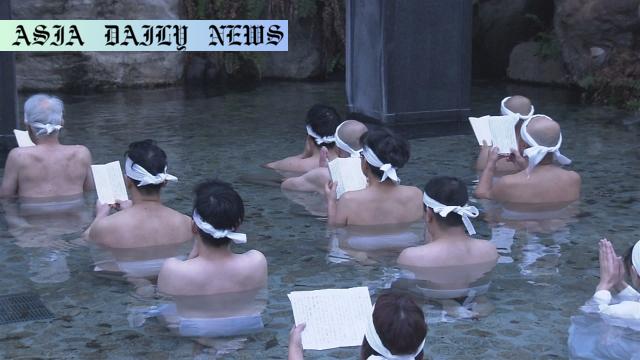Shinto priests and participants pray for disaster-hit areas in Ishikawa Prefecture through a traditional purification practice.
Participants engaged in a purification ritual in Ishikawa, Japan.
The ritual aimed at praying for recovery of disaster-hit areas.
Took place on the coldest day of the year according to the Japanese calendar.

The annual purification ritual in Ishikawa Prefecture, Japan, is a tradition deeply rooted in Shinto practices and culture. On Monday, recognized as the coldest day of the year by the traditional Japanese calendar, about 20 Shinto priests and other participants gathered at a shrine in Hakusan City to perform the heartfelt ceremony. Their goal was to pray for health, prosperity, and the recovery of disaster-stricken areas on the Noto Peninsula, which faced the aftermath of a powerful earthquake and torrential rains last year.
The event commenced at the break of dawn, with participants dressed in white loincloths or ceremonial white attire, symbolic of purity. They assembled at a location where the pure, cold water from the riverbeds of Mount Hakusan was stored, a site considered sacred and spiritually cleansing in Shinto belief. Before entering the freezing water, the participants warmed up their bodies with a series of rowing-like movements, chanting enthusiastically in unison. This act not only prepared them physically but also symbolized unity and strength among those present.
Following their preparations, each participant immersed themselves in the frigid waters, enduring the cold for approximately five minutes. During this time, they chanted prayers, which carried their hopes and messages to the deities. The ritual held deeper significance as participants had inscribed messages on their white headbands, expressing solidarity and wishing for the swift reconstruction of communities impacted by natural calamities on the Noto Peninsula. This personal and collective gesture was a powerful representation of Japan’s resilient community spirit and cultural heritage.
One participant, a man from Kanazawa City within Ishikawa Prefecture, vocalized his wishes for the people of the Noto Peninsula. He prayed for their return to normalcy and for a brighter future for the affected regions. Such heartfelt acts of solidarity echoed throughout the event, reinforcing the importance of community efforts during challenging times.
The ritual also served as a meaningful reminder of how cultural traditions can play a critical role in helping societies cope with adversity. Shinto rituals, like the one in Hakusan City, not only highlight Japan’s spiritual values but also its collective strength and hope in overcoming nature’s adversities. As similar practices continue across the country, they foster an enduring sense of connection, empathy, and resilience among individuals and communities.
This year’s purification ritual, which combined ancient customs with modern relevance, underscored the importance of looking ahead with hope, while honoring those who have endured hardship. Through acts of worship and communal solidarity, the Japanese people continue to inspire others worldwide with their perseverance and cultural richness.
Commentary
The annual purification ritual in Hakusan City is not merely about spiritual practices—it is an event that connects tradition with pressing contemporary issues. It demonstrates how cultural and religious heritage can provide solace, hope, and a sense of community in the aftermath of disasters. When participants step into the icy waters, they are not just performing a symbolic gesture but engaging in an act of solidarity and resilience for those affected by last year’s devastating earthquake and torrential rains on the Noto Peninsula. Such rituals are remarkable expressions of collective healing.
What makes this event truly inspiring is the emotional involvement of participants. The messages written on their headbands show how personal the act of prayer becomes in these moments. It reflects an essential part of being human—turning to collective traditions to make sense of tragedies and channel hope. As a man from Kanazawa City remarked, the event was a chance to pray for the restoration of disaster-hit areas, underlining the human necessity to help rebuild not just neighborhoods but lives as well.
This tradition also highlights the resilience embedded in Japanese culture. Time and again, Japan has faced and overcome natural disasters while maintaining its identity. Rituals like this offer people the strength to cope and start anew, underpinned by spiritual and cultural grounding. They emphasize the power of community and collective action, emerging as an example for others worldwide.
From an outsider’s perspective, events like these are profound reminders of the universal appeal of hope and perseverance. They transcend local boundaries and resonate with global audiences. Watching a community come together, especially on a frigid morning, to pray for the betterment of others is both humbling and inspirational. It shows that humanity, as diverse as it may be, searches for ways to connect, heal, and grow.
As we admire the tenacity and spirit shown by those involved, there is also an invitation for others to consider their own traditions and practices that bring communities together. After all, the essence of these rituals lies in their ability to remind us of our shared humanity, encouraging every individual to contribute—whether by prayer, action, or support—to the collective recovery and growth of society.


